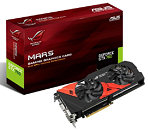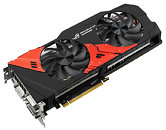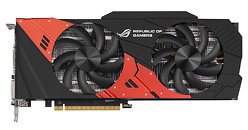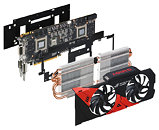Tuesday, November 19th 2013

ASUS Announces the ROG MARS 760 Dual-GPU Graphics Card
ASUS Republic of Gamers (ROG) today announced Mars 760, a graphics card that features two GeForce GTX 760 graphics-processing units (GPUs) for the ultimate gaming performance. Mars 760 outpaces even GeForce GTX Titan - with game performance that's up to 39% faster overall. Compared with GeForce GTX Titan, Mars 760 runs Bioshock Infinite 6% faster, Crysis 3 an impressive 14% quicker and increases Tomb Raider's performance by a remarkable 39%.
Mars 760 is a two-slot card that's packed with many exclusive ASUS technologies including DirectCU II for 20%-cooler and vastly quieter operation, DIGI+ voltage-regulator module (VRM) for ultra-stable power delivery and GPU Tweak, an easy-to-use utility that lets users push the two GTX 760 GPUs to extremes - easily and safely. An attention-grabbing LED even illuminates as Mars 760 works. Combined with 4 GB of GDDR5 video memory Mars 760 pumps visuals with incredibly high frame rates and no stutter, ensuring extremely smooth gameplay - even at very high resolutions, such as 2560x1600.Cool, quiet, stable, durable - and truly gorgeous
Exclusive DirectCU II technology puts 8 highly-conductive copper cooling pipes in direct contact with both GPUs. These pipes provide extremely efficient cooling - Mars 760 runs 20% cooler and vastly quieter than reference GeForce GTX 690 cards. Dual 90 mm dust-proof fans provide six times (6X) greater airflow than reference design.
Mars 760 is equipped with ROG's acclaimed DIGI+ voltage-regulation module (VRM), featuring a 12-phase power design that reduces power noise by 30% and enhances efficiency by 15%. It also widens voltage-modulation tolerance and improves overall stability and longevity - by two-and-a-half times (2.5X) above reference. Japanese-made black metallic capacitors offer 20%-better temperature endurance for a lifespan that's up to five times (5X) longer. The new card is also built with extremely heard-wearing polymerized organic-semiconductor capacitors (POSCAPs) and has an aluminum backplate, further lowering power noise, increasing durability, enhancing overclocking possibilities and improving stability.
Mars 760 even looks great, with a gorgeous LED light that glows a glorious red and pulsates majestically when Mars 760 is active - a stunning reminder of awesome power at work.
Easy tuning for awesome game performance
Mars 760 lets users push the two GTX 760 GPUs even further, with GPU Tweak - an exclusive tuning tool that allows quick, simple and safe control over video-memory clock speeds and voltages, cooling-fan speeds and power-consumption thresholds. The ROG edition of GPU Tweak included with Mars 760 also enables detailed GPU load-line calibration and VRM-frequency tuning, allowing for the most extensive control and tweaking parameters for maximum overclocking potential - all adjusted via an attractive and easy-to-use graphical interface. As well, the GPU Tweak Streaming tool lets users share on-screen action over the internet in real time - so others can watch live as games are played. It's even possible to add a title to the streaming window along with scrolling text, pictures and webcam images.
Mars 760 will be available from worldwide from the end of November 2013.
Mars 760 is a two-slot card that's packed with many exclusive ASUS technologies including DirectCU II for 20%-cooler and vastly quieter operation, DIGI+ voltage-regulator module (VRM) for ultra-stable power delivery and GPU Tweak, an easy-to-use utility that lets users push the two GTX 760 GPUs to extremes - easily and safely. An attention-grabbing LED even illuminates as Mars 760 works. Combined with 4 GB of GDDR5 video memory Mars 760 pumps visuals with incredibly high frame rates and no stutter, ensuring extremely smooth gameplay - even at very high resolutions, such as 2560x1600.Cool, quiet, stable, durable - and truly gorgeous
Exclusive DirectCU II technology puts 8 highly-conductive copper cooling pipes in direct contact with both GPUs. These pipes provide extremely efficient cooling - Mars 760 runs 20% cooler and vastly quieter than reference GeForce GTX 690 cards. Dual 90 mm dust-proof fans provide six times (6X) greater airflow than reference design.
Mars 760 is equipped with ROG's acclaimed DIGI+ voltage-regulation module (VRM), featuring a 12-phase power design that reduces power noise by 30% and enhances efficiency by 15%. It also widens voltage-modulation tolerance and improves overall stability and longevity - by two-and-a-half times (2.5X) above reference. Japanese-made black metallic capacitors offer 20%-better temperature endurance for a lifespan that's up to five times (5X) longer. The new card is also built with extremely heard-wearing polymerized organic-semiconductor capacitors (POSCAPs) and has an aluminum backplate, further lowering power noise, increasing durability, enhancing overclocking possibilities and improving stability.
Mars 760 even looks great, with a gorgeous LED light that glows a glorious red and pulsates majestically when Mars 760 is active - a stunning reminder of awesome power at work.
Easy tuning for awesome game performance
Mars 760 lets users push the two GTX 760 GPUs even further, with GPU Tweak - an exclusive tuning tool that allows quick, simple and safe control over video-memory clock speeds and voltages, cooling-fan speeds and power-consumption thresholds. The ROG edition of GPU Tweak included with Mars 760 also enables detailed GPU load-line calibration and VRM-frequency tuning, allowing for the most extensive control and tweaking parameters for maximum overclocking potential - all adjusted via an attractive and easy-to-use graphical interface. As well, the GPU Tweak Streaming tool lets users share on-screen action over the internet in real time - so others can watch live as games are played. It's even possible to add a title to the streaming window along with scrolling text, pictures and webcam images.
Mars 760 will be available from worldwide from the end of November 2013.




38 Comments on ASUS Announces the ROG MARS 760 Dual-GPU Graphics Card
4gb 670s would have been waaaaaaaaay better...Considering the ever lurking 4k
and not forgetting more vram
this seems too mediocre to me.
I'll use the GTX 780 Ti Winfroce as an example. Let's see.
Its faster, cost about the same, has 3GB of VRAM, shorter, takes less power, has no SLI issue potential.
Point dis-proven.
They compere it to the Titan like the Titan is relevant. It isn't, it died the day GTX 780 Ti came out. Hell, some say it died the day GTX 780 came out.
My suspicion is that a duel GPU card is a Premium Product, and justifying the cost mus-ta been the decision maker, and duel Pitcairn/Curacao card couldn't do better then $450 without some eyebrows being raised, and noses pointed away. Wanna make some money make a duel 760 VGA, and charge $600! Speculation, and poor insight :p.
and another thing is that for £$xxx (500quid) you get a card that beats a titan priced at 1k. (what about vs 780ti?)
if I were buying a card right now, id be a bit confused....
(or theyre testing the dual-gpu idea before going all out on 'zeus' (dual 780s) haha
Okay, it beats a Titan. Big Deal. So can all these cards (review dependent): 290x, 290, 780, 780Ti.
This would need to be really quite cheap to make it worthwhile. The memory is awful for the power. Good luck driving BF4 on a 1440p screen. Asus, wtf are you thinking?
Anybody would be far better served with any of 4 other single gpu cards all with 3-4Gb Vram.
Right now there are better options even for mini ITX - and probably cheaper too.
About a year ago they were going to come out with an HD 7870x2. Now that would of been killer as nothing except the GTX 690 would of been able to touch it. It's a shame they didn't release that card. This one is too little too late.
---------------------------
Asustek launches another overpriced proprietary board of dubious merit. The only thing less shocking is the predictable deluge of forum responses.
Well my suspicion is that the drivers for the 760 will not allow it. If they do great, otherwise the answer is no, or maybe. The maybe being Asus finding a clever way around it. Which they might have done since they included the SLI finger. Good question, no clear answer :p
Lets say in theory, MARS II does push 39% more performance than GTX Titan. You're looking at 1344 CC x2 for a total of 2688 Cuda Cores, per 1 MARS II. Since this is ASUS ROG Premium, Boost Frequency will probably be anywhere from 1079Mhz to 1200 Mhz. ARES II, Stock Boost Frequency was at 1100Mhz. A majority of 7970s were under that, GHZ Edition was at 1100Mhz, and 7990s were under that Stock Core Frequency.
If GTX Titan Reference is 2688 CC x 928 Mhz = 2,494,464.0
2,494,464.0 x 1.39 = 3,467,304.96; MARSII is up to 39% faster, overall, to GTX Titan.
3,467,304.96 (2688 cc)^-1 = 1289.92 Mhz at most.
Plausible? Who knows. Two things can be learned from this. An ASUS ROG MARS II could be looked at as a dual-GPU, GTX Titan-equivalent with better cooling, better binned GPUs, and higher Clock Frequencies. DirectCU II or Direct Cooling Unit v2.0 + 12 Power Phases would equate to better cooling even at OC Frequencies.
If GTX 780 Ti is 13.5% more performance, in theory, to GTX Titan, this would also mean that MARSII will be roughly 20 to 25% more than GTX 780 Ti. Looking at a possible performance gain of 8% more, realistically speaking, GTX 780 Ti versus MARS II.
(2688 cc)(1079 Mhz) / ((2880 cc)(928 Mhz)) = 1.0852, or 8.52%... Hard to tell without actual 3rd Party Benches...GTX Titans are basically the leftovers for K20 Tesla and K6000. They were apart of the yield that failed during production. Yes, you're right in a sense that they weren't made for Gaming in mind. They had 64bit double floating precision. More ideal for Workstation Graphic Cards, and that offered no performance gains towards PC Gaming. I believe NVidia's train of thought was to liquidate or make a profit off the left overs. Maximize revenue returns. The same thing is being done for G-Sync with the leftover inventory of Tegra4 Chips. Put them on PCBs, call it G-Sync, sell it to the NVidia consumers, bank more revenue returns, secretly push GTX 790 and Maxwell in between Q4 2013 to Q3 2014.
The main motivation-driver of the GTX Titan, by consumers, was the fact that it had 1.8 times the Cuda Cores of a GTX 680. GTX 690 would have 2.0 times the Cuda Cores of GTX 680, but the GTX Titan's main appeal was the amount of Cudas it has on a single 28nm die. That equates to less latency between GPU 1 and 2 on the GTX 690, and higher OC room. Again, those samples that failed short of the 2880 Cuda Core mark. More Cuda Cores equates to less time spent doing the same loads in Parallel Processing. Less time spent doing loads equates to higher FPS performance at some core frequency above 800 Mhz. Higher FPS equated to bragging rights, higher performance, Single-GPU domination, better game-play...
Maxwell is suppose to have over 3000 Cuda Cores on a 22nm die. Tenerifle 2.0 for AMD will possibly have a GPU with 2.0 times a Tahiti XL on a single die... Best case scenario, it will have 2.0 times a Hawaii XL on a single 22nm die.